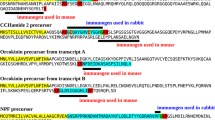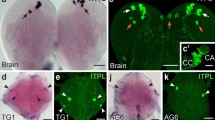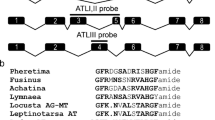Abstract
Endocrine cells in the larval midgut of Drosophila melanogaster are recognized by antisera to seven regulatory peptides: the allatostatins A, B, and C, short neuropeptide F, neuropeptide F, diuretic hormone 31, and the tachykinins. These are the same peptides that are produced by the endocrine cells of the adult midgut, except for short neuropeptide F, which is absent in adult midgut endocrine cells. The anterior larval midgut contains two types of endocrine cells. The first produces short neuropeptide F, which is also recognized by an antiserum to the receptor for the diuretic hormone leucokinin. The second type in the anterior midgut is recognized by an antiserum to diuretic hormone 31. The latter cell type is also found in the junction between the anterior and middle midgut; an additional type of endocrine cell in this region produces allatostatin B, a peptide also known as myoinhibitory peptide. Both types of endocrine cells in the junction between the anterior and middle midgut can express the homeodomain transcription factor labial. The copper cell region contains small cells that either produce allatostatin C or a combination of neuropeptide F, allatostatin B, and diuretic hormone 31. The latter cell type is also found in the region of the large flat cells. The posterior midgut possesses strongly immunoreactive allatostatin C endocrine cells immediately behind the iron cells. In the next part of the posterior midgut, two cell types have been found: one produces diuretic hormone 31, and a second is strongly immunoreactive to antiserum against the leucokinin receptor and weakly immunoreactive to antisera against allatostatins B and C and short neuropeptide F. The last part of the posterior midgut again has two types of endocrine cells: those that produce allatostatin A, and those that produce tachykinins. Many of the latter cells are also weakly immunoreactive to the antiserum against diuretic hormone 31. As in the adult, the insulin-like peptide 3 gene appears to be expressed by midgut muscles, but not by midgut endocrine cells.




Similar content being viewed by others
References
Adams MD, Celniker SE, Holt RA, Evans CA, Gocayne JD, Amanatides PG, Scherer SE, Li PW, Hoskins RA, Galle RF, George RA, Lewis SE, Richards S, Ashburner M, Henderson SN, Sutton GG, Wortman JR, Yandell MD, Zhang Q, Chen LX, Brandon RC, Rogers YHC, Blazej RG, Champe M, Pfeiffer BD, Wan KH, Doyle C, Baxter EG, Helt G, Nelson CR, Miklos GLG, Abril JF, Agbayani A, An HJ, Andrews-Pfannkoch C, Baldwin D, Ballew RM, Basu A, Baxendale J, Bayraktaroglu L, Beasley EM, Beeson KY, Benos PV, Berman BP, Bhandari D, Bolshakov S, Borkova D, Botchan MR, Bouck J, Brokstein P, Brottier P, Burtis KC, Busam DA, Butler H, Cadieu E, Center A, Chandra I, Cherry JM, Cawley S, Dahlke C, Davenport LB, Davies A, de Pablos B, Delcher A, Deng ZM, Mays AD, Dew I, Dietz SM, Dodson K, Doup LE, Downes M, Dugan-Rocha S, Dunkov BC, D Chen unn P, Durbin KJ, Evangelista CC, Ferraz C, Ferriera S, Fleischmann W, Fosler C, Gabrielian AE, Garg NS, Gelbart WM, Glasser K, Glodek A, Gong FC, Gorrell JH, Gu ZP, Guan P, Harris M, Harris NL, Harvey D, Heiman TJ, Hernandez JR, Houck J, Hostin D, Houston DA, Howland TJ, Wei MH, Ibegwam C, Jalali M, Kalush F, Karpen GH, Ke ZX, Kennison JA, Ketchum KA, Kimmel BE, Kodira CD, Kraft C, Kravitz S, Kulp D, Lai ZW, Lasko P, Lei YD, Levitsky AA, Li JY, Li ZY, Liang Y, Lin XY, Liu XJ, Mattei B, McIntosh TC, McLeod MP, McPherson D, Merkulov G, Milshina NV, Mobarry C, Morris J, Moshrefi A, Mount SM, Moy M, Murphy B, Murphy L, Muzny DM, Nelson DL, Nelson DR, Nelson KA, Nixon K, Nusskern DR, Pacleb JM, Palazzolo M, Pittman GS, Pan S, Pollard J, Puri V, Reese MG, Reinert K, Remington K, Saunders RDC, Scheeler F, Shen H, Shue BC, Siden-Kiamos I, Simpson M, Skupski MP, Smith T, Spier E, Spradling AC, Stapleton M, Strong R, Sun E, Svirskas R, Tector C, Turner R, Venter E, Wang AHH, Wang X, Wang ZY, Wassarman DA, Weinstock GM, Weissenbach J, Williams SM, Woodage T, Worley KC, Wu D, Yang S, Yao QA, Ye J, Yeh RF, Zaveri JS, Zhan M, Zhang GG, Zhao Q, Zheng LS, Zheng XQH, Zhong FN, Zhong WY, Zhou XJ, Zhu SP, Zhu XH, Smith HO, Gibbs RA, Myers EW, Rubin GM, Venter JC (2000) The genome sequence of Drosophila melanogaster. Science 287:2185–2195
Agricola H-J, Bräunig P, Meissner R, Nauman W, Wollweber L, Davis N (1995) Colocalization of allostatin-like immunoreactivity with other neuromodulators in the CNS of Periplaneta americana. In: Elsner N, Menzel R (eds) Learning and memory. Thieme, Stuttgart, p 616
Alpert S, Hanhan D, Teitelman G (1988) Hybrid insulin genes reveal a developmental lineage for pancreatic endocrine cells and imply a relationship with neurons. Cell 53:295–308
Andriès JC, Belemtougri G, Tramu G (1991) Multiple peptide immunoreacivities in the nervous system of Aeschna cyanea (Insecta, Odonata). Histochem 96:139–148
Angelini DR, Kaufman TC (2005) Comparative developmental genetics and the evolution of arthropod body parts. Annu Rev Genet 39:95–119
Baggerman G, Cerstiaens A, De Loof A, Schoofs L (2002) Peptidomics of the larval Drosophila melanogaster central nervous system. J Biol Chem 277:40368–40374
Baggerman G, Boonen K, Verleyen P, De Loof A, Schoofs L (2005) Peptidomic analysis of the larval Drosophila melanogaster central nervous system by two-dimensional capillary liquid chromatography quadrupole time-of-flight mass spectrometry. J Mass Spectrom 40:250–260
Becker MN, Brenner R, Atkinson NS (1995) Tissue-specific expression of a Drosophila calcium-activated potassium channel. J Neurosci 15:6250–6259
Boer HH, Schot LPC, Veenstra JA, Reichelt D (1980) Immunocytochemical identification of neural elements in the central nervous systems of a snail, some insects, a fish, and a mammal with an antiserum to the molluscan cardio-excitatory tetrapeptide FMRF-amide. Cell Tissue Res 231:21–27
Burke R, Commons E, Camakaris J (2008) Expression and localisation of the essential copper transporter DmATP7 in Drosophila neuronal and intestinal tissues. Int J Biochem Cell Biol 40:1850–1860
Cabrero P, Radford JC, Broderick KE, Costes L, Veenstra JA, Spana EP, Davies SA, Dow JA (2002) The Dh gene of Drosophila melanogaster encodes a diuretic peptide that acts through cyclic AMP. J Exp Biol 205:3799–3807
Chen Y, Veenstra JA, Davis NT, Hagedorn HH (1994) A comparative study of leucokinin-immunoreactive neurons in insects. Cell Tissue Res 276:69–83
Chintapalli VR, Wang J, Dow JAT (2007) Using FlyAtlas to identify better Drosophila melanogaster models of human disease. Nat Genet 39:715–720
Coast GM, Webster SG, Schegg KM, Tobe SS, Schooley DA (2001) The Drosophila melanogaster homologue of an insect calcitonin-like diuretic peptide stimulates V-ATPase activity in fruit fly Malpighian tubules. J Exp Biol 204:1795–1804
Dircksen H, Zahnow CA, Gaus G, Keller R, Rao KR, Riehm JP (1987) The ultrastructure of nerve endings containing pigment-dispersing hormone (PDH) in crustacean sinus glands: identification by antiserum against synthetic PDH. Cell Tissue Res 250:377–387
Dubreuil RR, Frankel J, Wang P, Howrylak J, Kappil M, Grushko TA (1998) Mutations of a spectrin and labial block cuprophilic cell differentiation and acid secretion in the middle midgut of Drosophila larvae. Dev Biol 194:1–11
Dubreuil RR, Grushko T, Baumann O (2001) Differential effects of a labial mutation on the development, structure, and function of stomach acid-secreting cells in Drosophila melanogaster larvae and adults. Cell Tissue Res 306:167–178
Fuse M, Zhang JR, Partridge E, Nachman RJ, Orchard I, Bendena WG, Tobe SS (1999) Effects of an allatostatin and a myosuppressin on midgut carbohydrate enzyme activity in the cockroach Diploptera punctata. Peptides 20:1285–1293
Grimmelikhuijzen CJP, Graff D (1986) Isolation of pyroGlu-Gly-Arg-Phe-NH2 (Antho-RFamide), a neuropeptide from sea anemones. Proc Natl Acad Sci USA 83:9817–9821
Hauser F, Williamson M, Cazzamali G, Grimmelikhuijzen CJP (2006) Identifying neuropeptide and protein hormone receptors in Drosophila melanogaster by exploiting genomic data. Brief Funct Genomic Proteomic 4:321–430
Hirth F, Hartmann B, Reichert H (1998) Homeotic gene action in embryonic brain development of Drosophila. Development 125:1579–1589
Hirth F, Loop T, Egger B, Miller DFB, Kaufman TC, Reichert R (2001) Functional equivalence of Hox gene products in the specification of the tritocerebrum during embryonic brain development of Drosophila. Development 128:4781–4788
Hoppler S, Bienz M (1994) Specification of a single cell type by a Drosophila homeotic gene. Cell 76:689–702
Hoppler S, Bienz M (1995) Two different thresholds of wingless signalling with distinct developmental consequences in the Drosophila midgut. EMBO J 14:5016–5026
Isabel G, Martin JR, Chidami S, Veenstra JA, Rosay P (2005) AKH-producing neuroendocrine cell ablation decreases trehalose and induces behavioral changes in Drosophila. Am J Physiol Regul Integr Comp Physiol 288:R531–R538
Johard HA, Enell LE, Gustafsson E, Trifilieff P, Veenstra JA, Nässel DR (2008) Intrinsic neurons of Drosophila mushroom bodies express short neuropeptide F: relations to extrinsic neurons expressing different neurotransmitters. J Comp Neurol 507:1479–1496
Johnson EC, Bohn LM, Taghert PH (2004) Drosophila CG8422 encodes a functional diuretic hormone receptor. J Exp Biol 207:743–748
Kean L, Cazenave W, Costes L, Broderick KE, Graham S, Pollock VP, Davies SA, Veenstra JA, Dow JAT (2002) Two nitridergic peptides are encoded by the gene capability in Drosophila melanogaster. Am J Physiol Regul Integr Comp Physiol 282:R1297–R1307
Lee KY, Horodyski FM, Chamberlin ME (1998) Inhibition of midgut ion transport by allatotropin (Mas-AT) and Manduca FLRFamides in the tobacco hornworm Manduca sexta. J Exp Biol 201:3067–3074
Liu F, Baggerman G, D’Hertog W, Verleyen P, Schoofs L, Wets G (2006) In silico identification of new secretory peptide genes in Drosophila melanogaster. Mol Cell Protoemics 5:510–522
McNulty M, Puljung M, Jefford G, Dubreuil RR (2001) Evidence that a copper-metallothionein complex is responsible for fluorescence in acid-secreting cells of the Drosophila stomach. Cell Tissue Res 304:383–389
Meier S, Sprecher SG, Reichert H, Hirth F (2006) Ventral veins lacking is required for specification of the tritocerebrum in embryonic brain development of Drosophila. Mech Dev 123:76–83
Nakagoshi H (2005) Functional specification in the Drosophila endoderm. Dev Growth Differ 47:383–392
Nakagoshi H, Hoshi M, Nabeshima Y, Matsuzaki F (1998) A novel homeobox gene mediates the Dpp signal to establish functional specificity within target cells. Genes Dev 12:2724–2734
Onken H, Moffett SB, Moffett DF (2004) The anterior stomach of larval mosquitoes (Aedes aegypti): effects of neuropeptides on transepithelial ion transport and muscular motility. J Exp Biol 207:3731–3739
Park D, Veenstra JA, Park JH, Taghert PH (2008) Mapping peptidergic cells in Drosophila: where DIMM fits in. PLoS ONE 3(3):e1896. doi:10.1371/journal.pone.0001896
Pascual N, Maestro JL, Chiva C, Andreu D, Belles X (2008) Identification of a tachykinin-related peptide with orexigenic properties in the German cockroach. Peptides 29:386–392
Radford JC, Davies SA, Dow JAT (2002) Systematic G-protein-coupled receptor analysis in Drosophila melanogaster identifies a leucokinin receptor with novel roles. J Biol Chem 277:38810–38817
Reichwald K, Unnithan GC, Davis NT, Agricola H, Feyereisen R (1994) Expression of the allatostatin gene in endocrine cells of the cockroach midgut. Proc Natl Acad Sci USA 91:11894–11898
Sakai T, Satake H, Takeda M (2006) Nutrient-induced α-amylase and protease activity is regulated by crustacean cardioactive peptide (CCAP) in the cockroach midgut. Peptides 27:2157–2164
Schonhoff SE, Giel-Moloney M, Leiter AB (2004) Minireview: development and differentiation of gut endocrine cells. Endocrinology 145:2639–2644
Schoofs L, Holman GM, Hayes TK, Nachman RJ, De Loof A (1991) Isolation, identification and synthesis of locustamyoinhibiting peptide (LOM-MIP), a novel biologically active neuropeptide from Locusta migratoria. Regul Pept 35:111–119
Schoofs L, Holman GM, Paemen L, Veelaert D, Amelinckx M, De Loof A (1993) Isolation, identification, and synthesis of PDVDHFLRFamide (SchistoFLRFamide) in Locusta migratoria and its association with the male accessory glands, the salivary glands, the heart, and the oviduct. Peptides 14:409–421
Siviter RJ, Coast GM, Winther AM, Nachman RJ, Taylor CA, Shirras AD, Coates D, Isaac RE, Nässel DR (2000) Expression and functional characterization of a Drosophila neuropeptide precursor with homology to mammalian preprotachykinin A. J Biol Chem 275:23273–23280
Strasburger M (1932) Bau, Funktion und Variabilität des Darmtractus von Drosophila melanogaster. Z Wiss Zool 140:539–649
Terhzaz S, Rosay P, Goodwin SF, Veenstra JA (2007) The neuropeptide SIFamide modulates sexual behavior in Drosophila. Biochem Biophys Res Commun 352:305–310
Veenstra JA (2009) Allatostatin C and its paralog allatostatin double C: the arthropod somatostatins. Insect Biochem Mol Biol 39:161–170. doi:10.1016/j.ibmb.2008.10.014
Veenstra JA, Costes L (1999) Isolation and identification of a peptide and its cDNA from the mosquito Aedes aegypti related to Manduca sexta allatotropin. Peptides 20:1145–1151
Veenstra JA, Davis NT (1993) Localization of corazonin in the nervous system of the cockroach Periplaneta americana. Cell Tissue Res 274:57–64
Veenstra JA, Hagedorn HH (1993) A sensitive enzyme immuno assay for Manduca allatotropin and the existence of an allatotropin-immunoreactive peptide in Periplaneta americana. Arch Insect Biochem Physiol 23:99–109
Veenstra JA, Lau GW, Agricola HJ, Petzel DH (1995) Immunohistological localization of regulatory peptides in the midgut of the female mosquito Aedes aegypti. Histochem Cell Biol 104:337–347
Veenstra JA, Agricola HJ, Sellami A (2008) Regulatory peptides in the fruit fly midgut. Cell Tissue Res 234:499–516
Winther AM, Nässel DR (2001) Intestinal peptides as circulating hormones: release of tachkinin-related peptide from the locust and cockroach midgut. J Exp Biol 204:1269–1280
Wu Q, Wen T, Lee G, Park JH, Cai HN, Shen P (2003) Developmental control of foraging and social behavior by the Drosophila neurpeptide Y-like system. Neuron 39:147–161
Yamanaka N, Yamamoto S, Žitňan D, Watanabe K, Kawada T, Satake H, Kaneko Y, Hiruma K, Tanaka Y, Shinoda T, Kataoka H (2008) Neuropeptide receptor transcriptome reveals unidentified neuroendocrine pathways. PLoS ONE 3(8):e3048. doi:10.1371/journal.pone.0003048
Yoon JG, Stay B (1995) Immunocytochemical localization of Diploptera punctata allatostatin-like peptide in Drosophila melanogaster. J Comp Neurol 363:475–488
Acknowledgements
I am grateful to Heinrich Reichert, Ping Shen, and Paul Taghert for generously sending various fly lines, to Frank Hirth, Cok Grimmelikhuijzen, Liliane Schoofs, Julian Dow, René Feyereisen, and Heinrich Dircksen for sharing valuable antisera, to Jean-Luc Morel for an aliquot of his rhodamine-labeled phalloidoin, to Venkat Chintapalli, Jing Wang, and Julian Dow for the timely addition of larval tissues to the Fly Atlas, and to two anonymous reviewers for constructive criticism of the manuscript.
Author information
Authors and Affiliations
Corresponding author
Rights and permissions
About this article
Cite this article
Veenstra, J.A. Peptidergic paracrine and endocrine cells in the midgut of the fruit fly maggot. Cell Tissue Res 336, 309–323 (2009). https://doi.org/10.1007/s00441-009-0769-y
Received:
Accepted:
Published:
Issue Date:
DOI: https://doi.org/10.1007/s00441-009-0769-y




